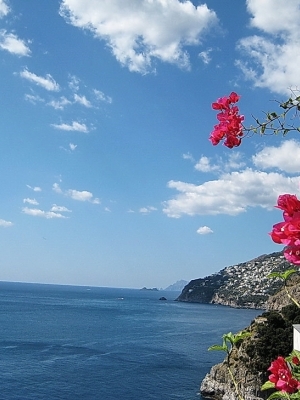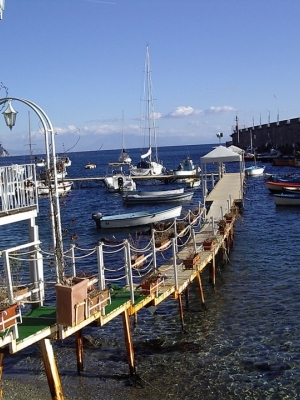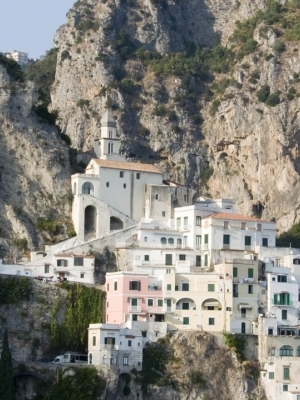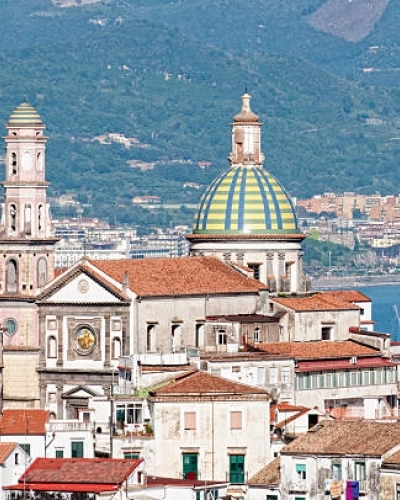Amalfi
"The largest town on Italy’s most breathtaking coastline."
Poised between the mountains and the sea, the narrow streets and passageways weave among monuments that testify to its former grandeur. The most important being the "Duomo" which dominates the central square, dedicated to Saint Andrew, originally founded in the 9th century, rebuilt in Romanesque style in the 11th century and then altered main times after. The façade and atrium date from the 1800s, but the carved bronze doors were cast in Constantinople around the year 1000. Escaping from the busy square filled with shops and cafes, you can stroll along the promenade looking down on to the pebble beach of Amalfi and across to the port.
One of the 'places to visit' along the Amalfi Coast is the Emerald Grotto. It is known for its natural "fireworks display" caused by light reflecting off its stalactites, and the jewel-like sheen of its green waters.
The cavern itself has an area of about 30 x 60 metres. At its highest point, its ceiling riches as high as 24 metres. From these heights hang Nature’s own "chandeliers": numerous stalactites, thin and delicate, catching the light. But the most unusual rock formations are the stalagmites, which seem to emerge from the sea, twisting upwards towards the ceiling. Some are over 10 metres high, and are so wide that it is impossible to encircle them with your arms. Beneath the water, covered by about four metres of water, is the original ceramic bed.
The Emerald Grotto’s key feature is its exquisitely brilliant blue and green waters, which were in fact the inspiration for its name. The colours of the water, reflecting of the ceilings and floors, cast a mysterious and almost holy glow on the walls of the cavern.
Address: Conca dei Marini
Cost of Entry: The average price of the boat ride is 5€.
Opening Hours: Daily from 9am – 4pm. However, tours may be cancelled in the event of bad weather
Ravello
"An enchanting town unspoilt by tourism"
Ravello, perched high above the Amalfi Coast, is a hidden gem that enchants visitors with its timeless beauty and serene atmosphere. Renowned for its breathtaking panoramic views of the Mediterranean Sea, Ravello offers a tranquil escape from the bustling coastal towns below. The town is a haven for art and music enthusiasts, hosting the annual Ravello Festival in its historic villas and gardens. Wander through the narrow cobblestone streets to discover charming squares, ancient churches, and hidden gardens adorned with vibrant blooms. Ravello's rich history is evident in its medieval architecture, including the iconic Villa Rufolo and Villa Cimbrone. With its cultural richness, stunning landscapes, and a sense of serenity, Ravello beckons travelers to immerse themselves in the magic of this elevated paradise on the Amalfi Coast.
Positano
"Few places are as picturesque as Positano, a pyramid of whitewashed houses spilling down from the mountain to the sea"
Positano is reached by a one-way road, inaccessible to large local buses and coaches. Our smaller vehicle will take you right down to Piazza Mulino, from here begins the journey on foot through the traffic-free lanes of Positano.
Nestled along the stunning Amalfi Coast in southern Italy, is a picturesque and enchanting coastal town that captivates visitors with its colorful cliffside houses cascading down to the Tyrrhenian Sea. Renowned for its breathtaking views, narrow winding streets, and vibrant bougainvillea-adorned architecture, Positano exudes a romantic and laid-back charm. The town's pebble beaches invite relaxation, and its clear blue waters beckon for a refreshing swim. Visitors can explore boutiques offering local crafts and the distinct Moda Positano fashion. Delightful cafes and restaurants dot the landscape, offering a taste of authentic Italian cuisine against a backdrop of sunsets that paint the sky in warm hues. Positano's timeless beauty and Mediterranean allure make it a must-visit destination for those seeking a blend of coastal serenity and Italian charisma.
Positano: Where every corner is a canvas of color and every sunset a masterpiece. Your journey to Positano begins with us!
Pompeii
"Considered as one of the most important archaeological sites in the world."
Pompeii was partially destroyed by an earthquake in 62 A.D., and then totally in 79 A.D. by the first recorded eruption of Mount Vesuvius that engulfed the city and its inhabitants with a terrible storm of cinders and ash. Pompeii was once a thriving commercial centre with a large seaport. At the time of the disaster there were approximately 30,000 inhabitants, so as you can imagine the site is very large and unfortunately badly destroyed, because of this reason an official guide of Pompeii is necessary, so they can bring the ruins back to life for you.
During your time in Pompeii amongst many other things you can see the ruts made by the wheels of the Roman chariots, remains of villas once belonging to rich Roman merchants, temples, the market place, shops and bars all dating back to 79A.D.
Maximise your time in Pompeii with one of our authorised guides.
Adding a Pompeii guide to your experience offers several benefits:
- In-Depth Knowledge: A guide provides a wealth of historical and cultural information, enriching your understanding of Pompeii's significance.
- Interactive Experience: Guides bring history to life with engaging storytelling, creating a more immersive and memorable visit.
- Priority Access: With skip-the-line privileges, a guide helps you make the most of your time, ensuring you spend it exploring rather than waiting in queues.
- Insider Insights: Guides can offer unique insights, hidden gems, and lesser-known details that might be overlooked during a self-guided tour.
- Answering Questions: Guides are there to answer your questions, providing a personalized experience tailored to your interests.
- Convenience: Having a guide streamlines the logistics of your visit, allowing you to focus on enjoying the site without worrying about navigation or ticketing.
In summary, a Pompeii guide enhances your overall experience by combining knowledge, convenience, and a personalized touch, making your visit more enjoyable and insightful.
Herculaneum
"Destroyed along side Pompeii by the famous volcanic eruption of Mount Vesuvius in 79A.D Herculaneum is now a famous archaeological site."
Much smaller than Pompeii, but unlike Pompeii, Herculaneum contains wonderfully preserved buildings. Swamped by a torrent of liquid mud and debris the once thriving residential seaside town soon had its beauty drowned. Occupied by the ‘aristocracy’ of Roman society drawn to the area by the splendid climate and desire to abandon the noise of large cities, Herculaneum was filled with elegantly villas. These buildings where not destroyed during the disaster, but instead when excavations started fantastic discoveries were made, the mud had actual helped preserve the town as a sort of enormous fossil, buildings indeed often kept intact. This is a splendid chance to see two storey Roman villas, beautiful mosaics, frescoes, pieces of carbonised furniture and other objects used by ancient Romans.
Vesuvius
"Vesuvius is neither the highest nor the most dangerous volcano in the world, but the eruption that buried Pompeii and Herculaneum has made it one of the most famous"
Vesuvius, mainland Europe's only active volcano, stands as a geological marvel and an icon of historical significance. While it may not claim the title of the highest or most dangerous volcano globally, the eruption in 79 AD, destroying the ancient Roman cities of Pompeii and Herculaneum under layers of volcanic ash, has made Vesuvius among the most renowned. With a history marked by approximately one hundred eruptions, the latest recorded in 1944, this 1,281-meter stratovolcano offers a captivating ascent, reachable after a brisk 30-minute walk. Once at the summit, visitors are treated to breathtaking views into the crater, across the Bay of Naples, and on the distant horizon, a poignant glimpse of Pompeii. Today, Vesuvius not only serves as a reminder of the formidable forces shaping our planet but beckons adventurous souls to explore its slopes and witness the harmonious interplay between nature's destructive might and the historical tapestry of Campania.
Naples City
Naples, a vibrant city in southern Italy, beckons visitors with its rich history, cultural treasures, and authentic Italian charm. Renowned for its delectable cuisine, Naples is the birthplace of pizza, and exploring the city means savoring mouthwatering slices in local pizzerias. The historic center, a UNESCO World Heritage site, boasts centuries-old architecture, including the Naples Cathedral and the Royal Palace of Naples. Art enthusiasts can explore the Naples National Archaeological Museum, home to an extensive collection of artifacts from Pompeii and Herculaneum. The city's lively atmosphere, narrow winding streets, and bustling markets, such as Spaccanapoli, provide a true taste of Italian daily life. With the backdrop of Mount Vesuvius and the Bay of Naples, the cityscape is both picturesque and evocative. Naples is not just a gateway to the Amalfi Coast and Pompeii but a destination in itself, offering a genuine Italian experience filled with history, art, and, of course, delicious food.
Sorrento
"Perched on tufa rock rising 50m above the sea, surrounded on one side by mountains and the other the Mediterranean, spritzed by lemon and olive groves, Sorrento is the perfect places for shopping, taking a walk, or just sitting in the main square people watching"
We have many fantastic day trips available every day from Sorrento. Reserve your private vehicle with English-speaking driver and discover the amazing sites that YOU and your family want to see during a fully customized tour just for you.
Situated in an area of singular beauty it is an enchanting place in all seasons. The locals have gone a long way to make visitors feel welcome and safe, the district is especially noted for its oranges, lemons, nuts and the town for inlaid woodwork (intarsia), lace and local liquors (limoncello).
SORRENTO is located on the Sorrento Peninsula that juts out toward the Island of Capri and separates the Bay of Naples from the Amalfi Coast. It is often considered to be part of the Amalfi Coast although technically it is not. Sorrento is the perfect arrival destination for people wanting to explore not only to the north, with interesting destinations such as Naples, Vesuvius, and Pompeii, but also to the south, with idyllic resorts like Positano, Amalfi and Ravello all within easy reach.
To the south of Sorrento lies one of the most enchanting shorelines that you could ever imagine - the Amalfi Coast. Twisting coastal roads wind along dramatic rock faces with houses perched on cliffs above the shimmering Mediterranean Sea. These charming villages offer fresh sea air, stunning views, tiny streets filled with local artisan shops and restaurants serving up the fresh catch of the day.
To the north are the two amazing archaeological sites Pompeii and Herculaneum where you can experience the Roman way of life from 2000 years ago in the most popular archeological sites in Italy as well as the towering Mt. Vesuvius, a still active volcano that is waiting to be explored. The countryside around Sorrento offers some of the best gourmet food that you can enjoy on a gastronomic tour, to learn about and taste gelato, olive oil, pizza, limoncello and the wonderful local wine.
Paestum
"Paestum is one of the best collections of Greek temples anywhere!"
South from Sorrento passing the famous beaches and buffalo farms we come to Paestum. The town was founded as Poseidon by Greeks in the 6th century and renamed Paestum when it became a Roman colony in 273 BC. The final conquerors were malaria–carrying mosquitoes, that killed of the population and kept the site wonderfully deserted for nearly a thousand years. Rediscovered in the 18th century, Paestum today offers the only well-preserved Greek ruins north of Sicily.
Paestum is a captivating archaeological site that transports visitors back in time to ancient Greece. Renowned for its remarkably well-preserved Greek temples, including the Temple of Hera, Temple of Athena, and the iconic Temple of Neptune, Paestum stands as a testament to the region's Hellenistic heritage. Strolling through the ancient city, visitors can explore well-preserved ruins, including the remnants of houses, agora, and impressive city walls. The Archaeological Museum of Paestum showcases a remarkable collection of artifacts, offering insight into the daily life and religious practices of the ancient inhabitants. Beyond its historical significance, Paestum is also celebrated for its surrounding lush landscapes and proximity to the Tyrrhenian Sea, adding a touch of natural beauty to this archaeological wonder.
Caserta
"Italy’s largest Royal Palace"
Caserta, only one hour by road from Sorrento, is home to the largest Royal Palace in Italy.
Designed by the great architect Luigi Vanvitelli in the middle of the 18th Century for King Charles lll of Bourbon, this is a true masterpiece of its time. The Royal Palace has 1200 rooms, 1790 windows and 94 staircases and is nicknamed the" Versailles of Naples" because of its design. The breathtaking gardens at the back of the Palace stretch back for 3 Km and in true Royal style finish with a superb waterfall. The Royal Palace is open to the public and is a wonderful chance to visit not only Caserta but also a well-kept place of history.
Cassino the Abbey and War Cemetery
"The Abbey of Monte Cassino and its War cemeteries is often a day of remembrance for the many people who visit this area."
The Benedictine Abbey was rebuilt after it was bombed to the ground by the Allies during the last World War in a battle against German troops. It is superbly positioned on top of Monte Cassino. The Abbey is only opened to the public for half a day, and with its spectacular views, and priceless treasures this is a great opportunity to see the Benedictine order of monks going about their daily routines.
In this area, you can also find a Commonwealth War Cemetery as well as a Polish War Cemetery, in these, lies the bodies of young men who lost their lives to the battle of Monte Cassino, and anyone visiting will certainly have brought home to them the sadness as well as the futility of war.
The War Graves Commission looks after the Commonwealth War Cemetery, and anyone looking for a particular plot will find that it is very easy to track down names.
Salerno
Salerno is an ancient city and comune in Campania (southwestern Italy) and is the capital of the province of the same name. It is located on the Gulf of Salerno on the Tyrrhenian Sea. The city is divided into three distinct zones: the medieval sector, the 19th century sector and the more densely populated post-war area, with its several apartment blocks.
Human settlement at Salerno has a rich and vibrant past, dating back to pre-historic times. The site has been one of the most important and strategic ports on the Mediterranean sea, yielding a rich Greco-Roman heritage. It was an independent Lombard principality, Principality of Salerno, in the early Middle Ages. During this time, the Schola Medica Salernitana, the first medical school in the world, was founded. In the 16th century, under the Sanseverino family, among the most powerful feudal lords in southern Italy, the city became a great centre of learning, culture and the arts, and the family hired several of the greatest intellectuals of the time. Later, in 1694, the city was struck by several catastrophic earthquakes and plagues. After a period of Spanish rule which would last until the 18th century, Salerno became part of the Parthenopean Republic.
In recent history the city hosted Victor Emmanuel III, the King of Italy, who moved from Rome in 1943 after Italy negotiated a peace with the Allies in World War II, making Salerno the home of the "government of the South" (Regno del Sud) and therefore provisional government seat for six months. Some of the Allied landings during Operation Avalanche (the invasion of Italy) occurred near Salerno. Today Salerno is an important cultural centre in Campania and Italy.
A patron saint of Salerno is Saint Matthew, the Apostle, whose relics are kept here at the crypt of Salerno Cathedral.
Further information about Salerno
.





